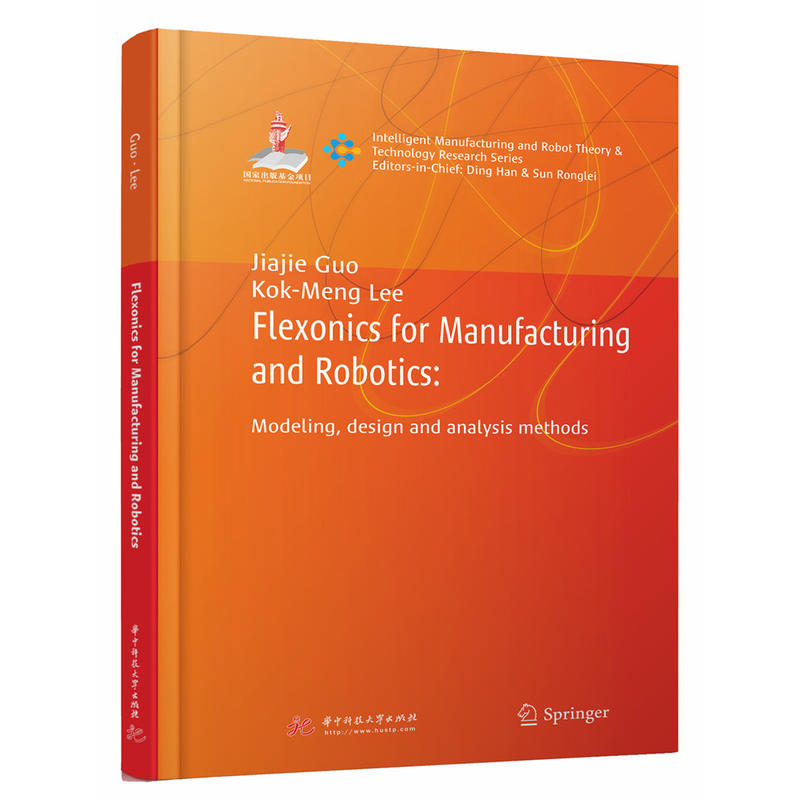
FLEXONICS FOR MANUFACTURING AND ROBOTICS:MODELING, DESIGN AN

温馨提示:5折以下图书主要为出版社尾货,大部分为全新(有塑封/无塑封),个别图书品相8-9成新、切口有划线标记、光盘等附件不全详细品相说明>>
- ISBN:9787568040549
- 装帧:一般铜版纸
- 册数:暂无
- 重量:暂无
- 开本:其他
- 页数:176
- 出版时间:2018-10-01
- 条形码:9787568040549 ; 978-7-5680-4054-9
本书特色
This book formulates the large deformation of a 3-D compliant beam as a boundary value problem (BVP). Unlike other methods, such as finite element (FE) method, that formulate problems based on displacements and/or rotational angles, the BVP formulation has been derived using curvatures that are more fundamental in presenting nonlinear geometries. Since in the case of finite rotation, superposition holds for curvatures but not for rotational angles, the model is much simpler and the resulting computational process is more efficient. The above advantages have been employed in this research to analyze compliant mechanism designs using curvature-based beam models. Along with the method of deriving the compliant members in the same global reference frame, a generalized constraint acting on a compliant mechanism is presented to replace traditional boundary constraints (such as fixed, pinned or sliding constraint) where none or only one degree of freedom (DOF) is allowed. Inspired by the dexterity of a natural biological joint that offers efficient multi-axis rotation, this research extends to the modeling method of a generalized constraint (or referred to here as a bio-joint constraint) to develop designs emulating commonly observed human motions of multi-DOFs . Using a multiple shooting method (MSM), the BVP is treated as an initial value problem and higher order accuracy can be achieved than finite element (FE) methods.
内容简介
This book formulates the large deformation of a 3-D compliant beam as a boundary value problem (BVP). Unlike other methods, such as finite element (FE) method, that formulate problems based on displacements and/or rotational angles, the BVP formulation has been derived using curvatures that are more fundamental in presenting nonlinear geometries. Since in the case of finite rotation, superposition holds for curvatures but not for rotational angles, the model is much simpler and the resulting computational process is more efficient. The above advantages have been employed in this research to analyze compliant mechanism designs using curvature-based beam models. Along with the method of deriving the compliant members in the same global reference frame, a generalized constraint acting on a compliant mechanism is presented to replace traditional boundary constraints (such as fixed, pinned or sliding constraint) where none or only one degree of freedom (DOF) is allowed. Inspired by the dexterity of a natural biological joint that offers efficient multi-axis rotation, this research extends to the modeling method of a generalized constraint (or referred to here as a bio-joint constraint) to develop designs emulating commonly observed human motions of multi-DOFs . Using a multiple shooting method (MSM), the BVP is treated as an initial value problem and higher order accuracy can be achieved than finite element (FE) methods.
目录
作者简介
Jiajie Guo?received the B.S. degree from the Department of Mechanics and Engineering Science at Peking University, Beijing, in 2006, and M.S. and Ph.D. degrees from Mechanical Engineering, Georgia Institute of Technology, Atlanta, in 2009 and 2011, respectively. He is currently an Associate Professor in the State Key Laboratory of Digital Manufacturing and Equipment and the School of Mechanical Science and Engineering at Huazhong University of Science and Technology, Wuhan, China. He is an IEEE and ASME member, and a program committee member of the IEEE/ASME International Conference on Advanced Intelligent Mechatronics. His current research interests include human-centered robotics, flexible mechatronics, manufacturing and system dynamics/control. He has published more than thirty peer-reviewed technical papers in journals and conferences, and has been awarded the best paper award from IEEE/ASME Transactions on Mechatronics in 2015. Kok-Meng Lee?earned his B.S. degree from the University of Buffalo, the State University of New York, Buffalo, NY, USA, in 1980, and S. M. and Ph. D. degrees from Massachusetts Institute of Technology, Cambridge, MA, USA, in 1982 and 1985, respectively. He is currently Professor of Mechanical Engineering at Georgia Institute of Technology, Atlanta, GA, USA. He is also Distinguished Professor with the State Key Laboratory of Digital Manufacturing Equipment and Technology, Huazhong University of Science and Technology, China, under Thousand Talents Plan. Prof. Lee’s research interests include system dynamics/control, robotics, automation, and mechatronics. He is a world renowned researcher with more than 30 years of research experience in magnetic field modeling and design, optimization and implementation of electromagnetic actuators. He has published over 150 peer-reviewed papers and he holds eight patents in machine vision, three degrees of freedom (DOF) spherical motor/encoder, and live-bird handling system. He is IEEE/ASME Fellow and was the Editor-in-Chief for the IEEE/ASME Transactions on Mechatronics from 2008 to 2013. Recognitions of his research contributions include the National Science Foundation (NSF) Presidential Young Investigator, Sigma Xi Junior Faculty Research, International Hall of Fame New Technology, and Kayamori Best Paper awards.?
-

铁道之旅:19世纪空间与时间的工业化
¥20.7¥59.0 -

金属材料及热处理
¥46.1¥72.0 -

实用电气计算
¥64.2¥88.0 -

中国传统民俗文化:建筑系列:中国古代桥梁
¥20.9¥58.0 -

嗨印刷工艺(Vol1烫印)(精)
¥147.4¥268.0 -

西门子S7-1200 PLC项目化教程
¥39.4¥54.0 -

变频器维修手册
¥69.3¥99.0 -

装配化工字组合梁设计
¥88.0¥160.0 -

气动系统装调与PLC控制
¥29.1¥39.8 -

高聚物粘结及其性能
¥34.8¥120.0 -

液压控制系统
¥12.7¥31.0 -

汽车风云人物
¥13.5¥50.0 -

品牌鞋靴产品策划-从创意到产品
¥26.5¥42.0 -

城市桥梁工程施工与质量验收手册-(含光盘)
¥61.6¥78.0 -

城镇道路工程施工与质量验收规范实施手册
¥16.4¥39.0 -

航空发动机限寿件概率损伤容限评估概述
¥67.8¥88.0 -

天才武器
¥42.0¥60.0 -

中国再制造进展
¥88.5¥118.0 -

中国烹饪工艺学粤菜教程
¥48.4¥59.8 -

蓝色水星球 重新思考我们在宇宙中的家园
¥60.7¥88.0











